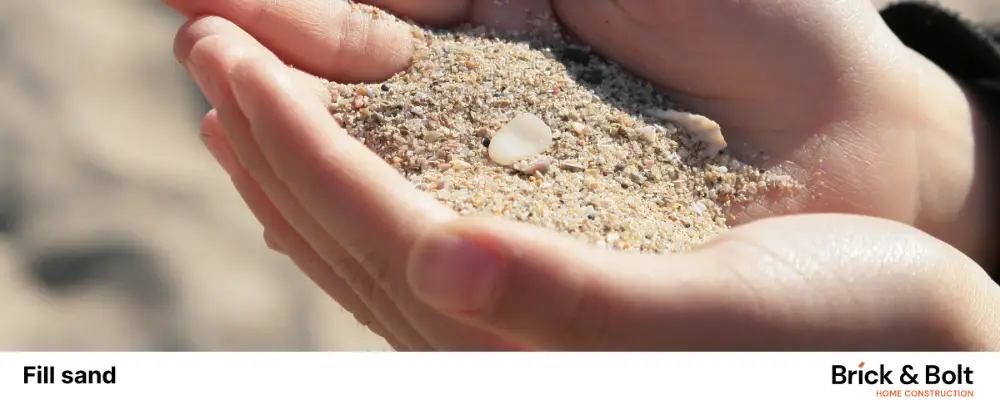Fill sand is one of the major materials used in construction work. It helps in levelling ground, acts as a base support for many structures, and aids in proper drainage. Knowing what fill sand is, the different types, where it is used, benefits of using it, and some of the frequently asked questions about fill sand, will be important for both a builder and a homeowner. Read on to learn about these aspects.
What is Fill Sand?
Fill sand, as the name suggests, is a kind of sand used to fill in different spaces such as holes or low spots on the ground. It is generally a mixture of silt, crushed aggregates and dirt. Its most common use is in construction to build a solid base to lay structures as well as buildings. Fill sand is extracted from natural sources like rivers and beaches. At factories, it can also be produced to meet specific needs.
The size of the granules of fill sand varies. Some fill sand has large-sized granules, while other types have smaller-sized granules. The size of the granules affects their application methods. Coarse sand is generally used for drainage, while fine sand is utilised in areas where finishing jobs are to be done. The appropriate type of fill sand depends on the nature of the job in question.
Types of Fill Sand Used in Construction
Several types are used during construction. Here are some of the most prominent:
1. Coarse Sand
Coarse sand has bigger-sized granules and is hence utilised for drainage purposes very often. It allows water to flow through efficiently, thus enabling recharge of groundwater. Coarse sand finds its application in backfills around the foundation and also in premixes of concrete. It is also largely used in landscaping and outdoor spaces.
2. Fine Sand
Fine sand includes smaller grains and is used in places where it would be visible. This type is generally more expensive and not easily available.
3. Sand for Utilities
Utility sand can be a mixture of coarse and fine grains. Due to these two grainy textures combined, many uses become possible. Common applications include filling around utility wires and pipes, like water and gas pipes. The support and protection that this gives them helps in preventing any kind of damage.
Uses of Fill Sand in Construction
Fill sand has many key applications in construction. Some of the major uses are as follows:
1. Preparation of Foundation
The purpose for which fill sand is mainly used includes the preparation of the foundation. A building is incomplete without a proper, solid foundation. It aids in providing an excellent base that prevents settling and shifting. If land is uneven, fill sand can be used to level the surface.
2. Landscaping
Fill sand is also utilised in landscaping projects, especially for levelling gardens and lawns. This is most commonly used to fill any low spots in a yard for level ground or to create pathways or other decorative features within a garden. It is also used to create porous layers to recharge groundwater.
3. Utility Installation
Filling sand is one of the important steps when laying utilities underground. This protection works as a covering layer for underground or ground level pipes and cables. The layer assists in preventing the deterioration of these utilities due to shifting soil. This, in turn, helps minimise any leakage problems that may arise with time. Utility lines that are buried for longer obtain safety with the help of fill sand.
4. Site Preparation
Site preparation is done before construction. Fill sand is used in levelling and filling the area where buildings are to be constructed. This stabilises the ground, and makes it ready for construction.
5. Erosion Control
Fill sand will provide further assistance in preventing erosion in areas that are susceptible to the runoff of water. Due to the stability of its surface, fill sand will prevent soil from washing away during heavy rains. This becomes extremely important at construction sites where the issue of soil stability may be in question.
Advantages of Fill Sand
Many benefits come with using fill sand. Here are some of the key advantages:
1. Stability
Stability is the reason why fill sand is used as a base to strengthen structures. There should be stability so that the buildings would remain safe and secure for quite a longer period. A solid foundational base will help avoid problems such as cracks and shifting.
2. Good Drainage
Fill sand is characterised by good drainage properties. The size of the sand grains allows water to pass with much ease, and this prevents problems of puddle formation and flooding.
3. Versatility
Fill sand is versatile and can be employed as the base or for several purposes being pursued, be it landscaping or placing utilities. Thus, it is used for foundations in a broad range of projects, and is a valuable resource for builders and contractors.
4. Ease of Handling
Filling sand is lightweight and easy to handle. Therefore, it is easy to transport to construction sites. The ease of handling reduces the cost of labour involved and increases efficiency in a process which otherwise takes a lot of time during construction.
5. Cost-Effective
Fill sand is usually cheaper compared to other fill materials, as it is largely made from waste materials or impure sand.
Conclusion
Fill sand is one of the major materials used in construction for its stability, good drainage, and versatility. Understanding the types of fill sand and the uses for each significantly aids builders and homeowners in making informed choices for their projects. Indeed, fill sand is an important material to consider in achieving successful construction results, whether in preparing a foundation, landscaping, or installing utilities.
If fill sand is utilised properly, it can be used in the building of solid and enduring structures; this will further improve every construction undertaking. As you plan for your next project, consider the many benefits of fill sand and how it can contribute to your success.

